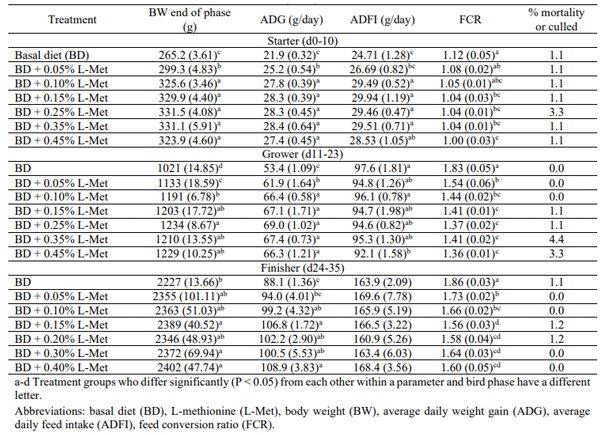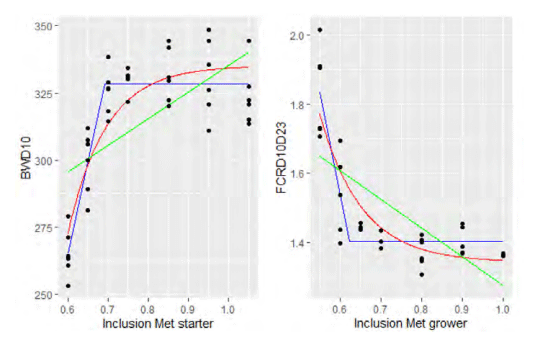I. Introduction
Methionine plus Cysteine (Cys) requirement of poultry and swine has been determined using graded levels of DL-Met. Currently, Aviagen recommends 0.95, 0.87, and 0.83% SID Met plus Cys for starter, grower, and finisher phases of Ross 308 broilers (Aviagen, 2019). Cobb recommends 0.88, 0.80, and 0.74% SID Met plus Cys for the respective growth phases (Cobb, 2018). Similarly, Brazilian tables recommend 0.99, 0.97, and 0.91% SID Met plus Cys for broilers starter, grower, and finisher phases (Rostagno et al. 2005). In 2005, Garcia and Batal demonstrated in two executive experiments with male Cobb 500 broilers, the SID SAA recommendations (%) for the first 4, 7, and 21 days of life were 0.88 and 0.71, 0.87 and 0.75, and 0.83 and 0.75 (used DL-Met to create the incremental SID SAAs). In this experiment, we determined the SID Met plus Cys requirement of broilers in feeds containing only L-Met from protein bounded L-Met and supplementary L-Met. There was no attempt to compare methionine sources in this experiment.
II. Method
One day old male Ross 308 broilers (n=1890) were used in this study. Part of the chickens (n=630 test birds) were entered into 42 pens (1 m2 ). The remaining chickens were kept in two large pens (pool birds) and were kept on a commercial starter and grower feed (Millecam et al. 2021). Pool birds were entered into test pens at day 10 and 23 after removing the previous birds to avoid a carryover effect from the previous feeding phases. Basal diets (published at Millecam et al. 2021) were formulated according to Ross 308 (Aviagen, 2019) except for SID Met plus Cys (0.60, 0.55 and 0.50 during the starter, grower and finisher phases, respectively; Millecam et al. 2021). L-Met was added to create the 6 additional levels of SID Met plus Cys. Six pens containing 15 birds each were randomly allocated to the treatment groups. Six pens per treatment group in a regression analysis experimental setup is considered appropriate because means are not compared rather than slope of the lines. Accuracy of the lines are depending to the dots created by graded levels of SID SAAs. Pens were weighed at the beginning and end of feeding phases. Feed intake was measured accordingly. At the end of finisher phase, four birds per pen were individually weighed, slaughtered, and carcass, breast, and leg weight were measured. Data were analyzed using R (R core team, 2020). Two statistical models were applied to the data (a linear broken line and an exponential asymptotic model). The model with the highest R 2 was selected and used to determine the SID SAA requirements. Linear regression models (procedure lm of the core package) were used to determine the effect of treatment. Post hoc least significance difference tests with no adjustment for multiple comparisons was applied to compare means (P< 0.05).
III. Results
There was a progressive response in starter, grower, and finisher birds by the addition of LMet to the basal diet (Table 1 and 2). Addition of L-Met significantly increased performance and slaughter parameters until a plateau was achieved. For most of the parameters, the broken line linear model showed the best fit (Figure 1). An overview of estimated SID Met plus Cys are given in table 3. The estimated numbers are variable depending on the parameter and age. According to the best fit, SID Met plus Cys was estimated to be 0.69, 0.66, and 0.62% for starter, grower and finisher phases, respectively.
Table 1 – Mean performance parameters of broilers. The standard error of mean is defined in brackets (SEM).
Table 2 – Mean slaughter performance of broilers. The standard error of mean is defined in brackets (SEM).
Table 3 – Optimal digestible methionine plus cystine level in the feed of birds in starter, grower and finisher phase for every performance and slaughter parameter.
Figure 1 – Exponential asymptotic (red) and linear broken line (blue) models fitted to body weight gain at day 10 (BWD10) and Feed conversion ratio between day 10 an d23 (FCRD10D23). Linear model did not show a fit to any of the parameters therefore was excluded from data.
IV. Discussion
The nutrient requirement of broilers is affected by different factors such as age, gender, and breed. Consequently, performance of broilers is measured to be affected by such factors (Livingston et al. 2020). SID Met plus Cys requirement of broilers follows a similar trend with an exception. SID Met plus Cys requirements is additionally affected by the source of Met used to implement the incremental levels of SID Met plus Cys. Majority of studies looking at SID Met plus Cys are performed using DL-Met thus efficacy of DL-Met is incorporated in the known SID Met plus Cys requirements. Herein, graded levels of L-Met were used to create the incremental levels of SID Met plus Cys. To achieve the maximum performance of broilers, 0.27. 0.19, and 0.14% less SID Met plus Cys was required compared with breeder recommendations. According to Aviagen, broilers need 0.95, 0.87, and 0.83% SID Met plus Cys for starter, grower, and finisher phases, respectively, while in this experiment 0.69, 0.66, and 0.62% SID Met plus Cys were required to achieve the maximum performance of Ross 308 broilers. Whether or not these observed lower SID Met plus Cys requirements could be attributed to the stereoisomers of Met should be further elucidated.
Presented at the 33th Annual Australian Poultry Science Symposium 2022. For information on the next edition, click here. 














.jpg&w=3840&q=75)